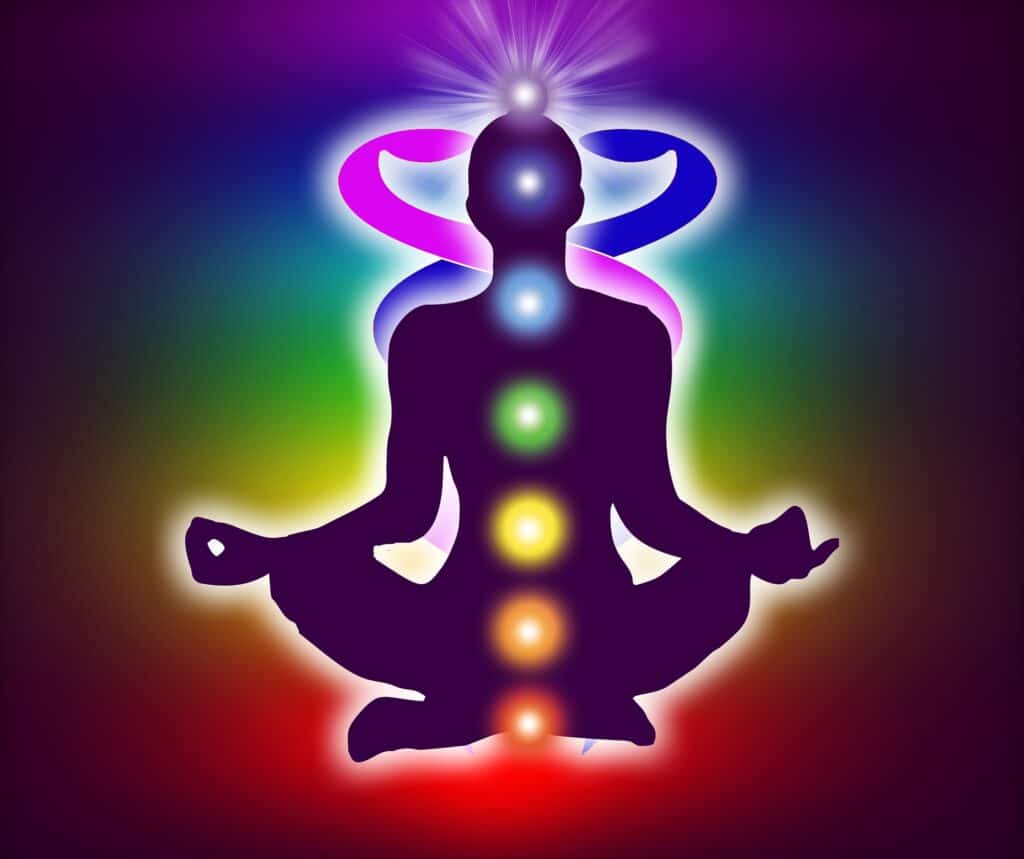When it comes to Kundalini awakening safety, there is much debate and misinformation surrounding this ancient practice. In this blog post, we will delve into the intricacies of Kundalini energy and its role in spiritual growth while addressing concerns about potential dangers associated with awakening this powerful force.
We’ll look into different techniques for safely stirring up Kundalini energy and the diverse advantages that may come from this process, such as amplified intuition and inventiveness, heightened mental lucidity, and greater emotional stability. Additionally, we’ll discuss common physical symptoms that may arise during a Kundalini awakening and ways to manage these manifestations effectively.
Lastly, our focus on Kundalini awakening safety includes an examination of precautions one should take when embarking on this transformative journey – from finding qualified teachers or guides to incorporating grounding practices into your daily routine. By dispelling misconceptions about safety concerns related to Kundalini yoga and meditation practices, you’ll better understand how to harness this divine energy responsibly for personal growth and well-being.
Understanding Kundalini Awakening

Kundalini awakening is an ancient practice that involves channeling powerful energy from the base of the spine up through the chakras to expand consciousness and transform one’s life. This process can lead to a heightened awareness of intuition, a deep sense of purpose, and significant life changes. The kundalini energy, often referred to as “serpent power,” lies dormant at the base of our spine until it is awakened through various practices.
The role of Kundalini in spiritual growth
In many spiritual traditions, kundalini awakening is considered an essential part of personal development and self-realization. When this sacred power stirs within us, we may gain access to heightened states of awareness and achieve a deep understanding of our inherent being. Kundalini awakening can facilitate greater self-awareness and clarity about one’s life path.
Different methods for awakening Kundalini
There are several ways to awaken your kundalini energy safely under proper guidance:
- Kundalini Yoga: A specific form of yoga that combines physical postures (asanas), breathwork (pranayama), chanting (mantras), and meditation techniques specifically designed for activating kundalini such as those taught by KRI – The Kundalini Research Institute.
- Meditation Practices: Certain types, such as focused attention on sushumna nadi or third eye chakra during meditations, can help awaken kundalini.
- Energy Work: Reiki, acupuncture, and other forms of energy healing can facilitate awakening by removing blockages in our energetic system.
- Spiritual Guidance: Working with a qualified spiritual teacher or mentor who has experience guiding others through their kundalini awakening journey is invaluable for ensuring safety and support during this intense experience.
Regardless of the chosen method, it’s essential to approach your kundalini awakening with an open mind and heart while respecting the powerful nature of this transformative process. Remember that each person’s journey will be unique, so it’s crucial to listen to your intuition as you explore different practices and techniques on your path toward self-realization.
Approaching Kundalini awakening cautiously is a must for those seeking spiritual growth through this powerful process. Investigating the potential of Kundalini rousing can bring about profound otherworldly improvement, so let us think about what advantages this training may offer.
Benefits of Kundalini Awakening

A kundalini awakening allows long-term positive change by helping individuals become who they are meant to be. It can lead to heightened awareness, potentially resulting in meaningful internal growth and improved well-being. Some key benefits include enhanced intuition and creativity, increased mental clarity and focus, as well as greater emotional balance.
Enhanced Intuition and Creativity
When awakened, the kundalini energy stimulates the higher chakras responsible for intuition (third eye chakra) and creative expression (throat chakra). As a result, many people report experiencing heightened intuitive abilities such as clairvoyance or telepathy after their kundalini awakens. Additionally, this newfound connection with one’s divine essence often leads to bursts of inspiration that fuel artistic pursuits or innovative problem-solving skills.
Increased Mental Clarity and Focus
Kundalini awakening also has a profound impact on cognitive functioning. The flow of energy through the Sushumna nadi clears blockages in the subtle body channels while balancing both hemispheres of the brain. This process results in better concentration levels along with improved memory retention capabilities – essential factors for success in any field. Furthermore, practitioners may find themselves more attuned to spiritual experiences leading up to enlightenment, making it easier than ever to achieve inner peace during meditation practice sessions.
Greater Emotional Balance
- Serenity: With consistent kundalini yoga practices like hatha yoga techniques combined alongside regular meditation routines over time comes an increased sense of calmness throughout daily life events – even amidst chaos or stress-filled situations.
- Emotional Resilience: As kundalini energy works its way through the chakras, it helps to release emotional blockages and past traumas. This process allows individuals to develop a greater capacity for coping with challenges and setbacks in their lives.
- Compassion: The awakening of kundalini also fosters an enhanced connection with one’s own divine essence, leading to a deepened understanding of interconnectedness among all living beings. This heightened awareness often translates into feelings of empathy and compassion towards others, fostering harmonious relationships within personal circles and broader communities.
In summary, the benefits associated with kundalini awakenings are vast and transformative on various levels – physically, mentally, and spiritually. By embarking upon this spiritual path under proper guidance from qualified teachers at places like the Kundalini Research Institute, individuals can experience significant improvements not only regarding their overall well-being but also when it comes to achieving true enlightenment itself ultimately.
Kundalini Awakening offers a plethora of advantages, from better concentration and understanding to greater instinctive acumen and imagination. However, it is important to be aware of the physical symptoms that may arise during this process in order to manage them effectively.
Physical Symptoms during Kundalini Awakening

Some may experience physical symptoms, such as elevated body temperature or tingling sensations along the spine, which are indicative of energy flow through their system. These manifestations are generally temporary but indicate that energy is flowing freely throughout their system.
Common physical signs during the process
As the kundalini energy rises through the sushumna nadi (central channel), it can cause various physical sensations and experiences. Some common symptoms include:
- A feeling of tingling or buzzing in various parts of the body, particularly down the spine, may be experienced as kundalini energy moves up through the sushumna nadi.
- Involuntary muscle movements or spasms, known as kriyas.
- Increase in body temperature, sometimes accompanied by sweating or chills.
- Sensations of pressure at specific points on the head, such as the crown chakra or third eye chakra.
- Rapid heart rate and changes in breathing patterns.
Note that these signs may differ from individual to individual and should not be thought of as inherently perilous. If you have any doubts or worries about your well-being during this process, seek the advice of an experienced professional.
Ways to manage these symptoms
If you’re experiencing intense physical sensations during your kundalini awakening journey, there are several strategies you can employ to help manage them effectively:
- Maintain a consistent meditation practice: Regularly practicing mindfulness techniques like breath awareness will help calm your nervous system and allow you to manage the energy flow within your body better.
- Engage in grounding activities: Activities such as walking barefoot on grass, gardening, or spending time in nature can help anchor and stabilize your energy. You may also consider incorporating hatha yoga practices into your routine for additional support.
- Seek guidance from experienced teachers: Connecting with a knowledgeable mentor or joining a supportive community like the Kundalini Research Institute will provide valuable insights and resources for navigating this intense experience safely.
- Nourish yourself properly: Eating a balanced diet rich in nutrients and staying hydrated is essential during any spiritual practice. Proper nutrition will help support your physical body as it undergoes these energetic shifts.
Incorporating these strategies into your daily life will enable you to navigate the kundalini awakening process more smoothly while ensuring you remain safe and supported throughout this transformative journey.
Be conscious of any corporeal manifestations that may arise during Kundalini Awakening, and exercise vigilance when partaking in this practice. Precautions should be taken for safe practice, such as finding qualified teachers or guides and incorporating grounding practices into your routine.
Precautions for Safe Practice
Before beginning this process, it is important to secure the necessary guidance and support from experienced teachers or mentors in order to minimize potential risks associated with kundalini awakenings. Ensuring you have appropriate support from experienced teachers or mentors will help minimize potential risks associated with intense energetic experiences.
Finding Qualified Teachers or Guides
The first step in ensuring a safe and effective kundalini awakening is finding qualified teachers or guides who can provide the necessary instruction and support. Look for instructors certified by reputable organizations such as the Kundalini Research Institute. These professionals have undergone extensive training in kundalini yoga techniques and meditation practices, equipping them to safely guide you through your spiritual journey.
- Ask for recommendations from friends or fellow spiritual seekers who have had positive experiences with their own awakenings.
- Research local yoga studios and wellness centers offering kundalini classes led by certified instructors.
- Think about taking part in seminars, getaways, or web-based courses directed by esteemed authorities in the Kundalini Yoga field.
Importance of Grounding Practices
In addition to seeking guidance from qualified teachers, incorporating grounding practices into your daily routine can help maintain balance during your kundalini awakening process. Grounding exercises connect you to the earth’s energy, promoting stability amidst powerful energetic shifts taking place within your body. Some effective grounding techniques include:
- Hatha Yoga: Practicing hatha yoga postures helps stabilize both mind and body while preparing you physically for more advanced forms of practice like kundalini yoga.
- Walking in Nature: Spending time outdoors, particularly walking barefoot on grass or soil, can help you connect with the earth’s energy and feel more grounded.
- Breathing Exercises: Deep breathing exercises such as diaphragmatic breathing or alternate nostril breathing (Nadi Shodhana) can calm your nervous system and promote a sense of balance during intense experiences.
Taking these precautions will ensure that your kundalini awakening journey is both safe and transformative. Remain aware of your body’s needs, rely on inner wisdom and access specialist help if necessary. With proper support and practice, you’ll be well on your way to unlocking the divine essence within you through this ancient spiritual path.
Taking precautions for safe practice is important when engaging in Kundalini Awakening, as it can be a powerful experience. It is essential to clear up any misunderstandings regarding safety when undertaking Kundalini Awakening to ensure the experience goes smoothly.
Misconceptions About Safety Concerns

Many concerns surrounding kundalini awakenings stem from misunderstandings about what this process entails. By addressing common misconceptions around safety issues, we can help dispel fears and provide a clearer understanding of the benefits and precautions associated with awakening one’s kundalini energy.
Myth 1: Kundalini Awakening is Inherently Dangerous
The belief that kundalini awakening is inherently dangerous stems from a lack of knowledge about the practice itself. While it’s true that an intense experience may occur during the process, proper guidance and support from experienced teachers or mentors can ensure a safe journey. As mentioned earlier, grounding practices such as hatha yoga or meditation are essential to maintaining balance throughout your spiritual path.
Myth 2: Only Certain People Can Awaken Their Kundalini Energy Safely
This misconception suggests that only those who have attained enlightenment or possess some unique ability can safely awaken their kundalini energy. However, anyone committed to personal growth and willing to follow proper guidance can embark on this transformative journey. The key lies in approaching the practice with respect, dedication, and an open mind.
Myth 3: Once Kundalini Awakens, It’s Dangerous To Stop Practicing Yoga Or Meditation
Kundalini awakening does not mean you must continue practicing yoga or meditation indefinitely for fear of causing immense havoc within your system if you stop abruptly after your kundalini awakens. Instead, it’s essential to maintain a balanced lifestyle and continue incorporating grounding practices that support your overall well-being. Integrate these techniques into your daily life as tools for personal growth to maintain a balanced lifestyle and support overall well-being.
Myth 4: Kundalini Awakening Leads To A Dark Night Of The Soul
The term “dark night of the soul” refers to a period of intense spiritual struggle often associated with feelings of despair or hopelessness. While some individuals may experience challenging emotions during their kundalini awakening process, this does not mean they are destined for a dark night. With proper guidance and support from experienced teachers or mentors, most people can navigate through any emotional turbulence and emerge stronger than before.
Myth 5: Kundalini Yoga Techniques Are Secret And Dangerous If Practiced Incorrectly
While certain Kundalini yoga techniques were once kept secret in ancient times, today, many resources are available online and through reputable institutions such as the Kundalini Research Institute. These teachings have been carefully preserved by dedicated practitioners who understand their power and potential impact when practiced correctly under proper guidance. It’s important to remember that, like any other form of yoga or meditation practice, safety lies in approaching kundalini with respect, dedication, and an open mind.
Frequently Asked Questions Kundalini Awakening Safety
Is it safe to do Kundalini Awakening?
Yes, Kundalini Awakening is generally safe when practiced under the guidance of a qualified teacher or guide. It’s essential to approach this practice with respect and follow proper techniques to ensure a smooth and beneficial experience. Grounding practices and managing symptoms can also contribute to safety during the process.
What are the consequences of Kundalini?
Kundalini awakening can lead to various physical, emotional, and spiritual benefits such as enhanced intuition, increased mental clarity, greater emotional balance, and overall well-being. However, improper practice may result in temporary discomfort or imbalances that can be managed with appropriate guidance.
How can we prevent Kundalini awakening?
If you wish not to awaken your Kundalini energy intentionally, avoid engaging in specific practices designed for its activation (e.g., certain yoga poses or meditation techniques). Instead, focus on general mindfulness practices that promote relaxation without targeting the Kundalini directly.
What does Kundalini do to your brain?
Kundalini awakening has been associated with changes in brain activity, leading to heightened awareness and altered states of consciousness. This may result in improved cognitive function, such as increased creativity, better problem-solving skills, enhanced memory retention, and reduced stress levels, among other potential benefits.
Conclusion
In conclusion, Kundalini awakening can be a powerful spiritual growth and personal transformation tool. However, it is important to approach the process with caution and mindfulness of potential physical symptoms. By finding qualified teachers or guides and incorporating grounding practices into your routine, you can safely explore the benefits of Kundalini Awakening.
Remember that misconceptions about safety concerns may lead to unnecessary fear or risk-taking during the process. Take time to educate yourself on safe practices and listen to your body’s signals throughout the journey.









